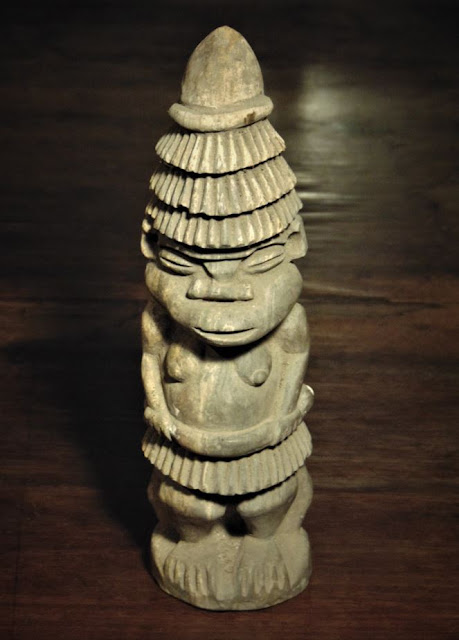Totumo-Fruit from Calabash Tree Crescentia cujete engraved and painted as Curi Rodent Animal (Cavia anolaime / Cavy or Guinea Pig)
Acquired from Mrs. Maria del Socorro Artcraft at San Alejo Artisan market, Medellin May 1997
Ancient "precolombian" indigenous "grave gift" or grave good excavated and distributed by an "Guaquero" from Southern Colombian San Agustin indigenous reserve that represents an pregnant woman.
The ceramic was acquired for CID Institute Museum in August 1985 in San Agustin, Huila, Southern Colombia
Acquired from Mrs. Maria del Socorro Artcraft at San Alejo Artisan market, Medellin May 1997
Acquired from Mrs. Maria del Socorro Artcraft at San Alejo Artisan market, Medellin May 1997
Traditional Artcraft Sculpture Pattern from San Agustin / Huila / Southern Colombia acquired for CID Institute Museum in July / August 1985
Wooden Dolphin Sculpture / Donation of Mrs. Zanger-Montoya 2014
Wooden Dolphin Sculpture / Donation of Mrs. Zanger-Montoya 2016
Authentic ceramic artcraft model of traditional rural open countryside passenger and merchandise transport busses called "Chiva"
Donation to CID Institute Museum by Dr. Mario Montoya Hernandez, Tamesis, September 1985
Handmade Sculpture made by Mr. Aurelio, Chief of Tribe of a Huitoto Indian Community from La Chorrera, Colombian Caqueta Forest
Wooden sculpture of a Woman working on a mortar handmade by Luis Alberto Jimenez Artesano, Talla en Maderas de Naranjo y Guacamayo, Vereda Tumbabarreto, Parcialidad Indigena Lomaprieta,. Riosucio, Caldas, Colombia
Totumo-Fruit from Calabash Tree Crescentia cujete
Flying serpents or dragons in precolombian design represent helpforce personalities of godesses. The tin is a present of Mrs. Luz Beatriz Gaviria to CID Institute Museum from 1991
Precolombian Sculpture in Cornalina Stone
The precolombian godess miniature from Cornalina Stone was donated to CID Institute Museum by Mrs. Myriam Reina from Santa Marta PUERTO LIBRE and KORALES Artcraft Stores in 1991 as "Rana Tairona" Necklace Pendant but represents more probable a precolombian personality type similar as the San Agustin culture statues.
donation to CID Institute Museum Ethnological Artcraft Collection from Mrs. Dra. Sol Montoya in 1983
Recent Indigenous Statue Ceramic
a present from Dra. Sol Montoya to the parents of the CID Institute Museum Director during the 1990ies
Recent Indigenous Head Ceramic
a present from Dra. Sol Montoya to the parents of the CID Institute Museum Director during the 1990ies
Wooden Sculpture with traditional "Varniz de Pasto" natural colour design from Southern Colombia
a donation to CID Institute Museum Ethnological Artcraft Collection from Mrs. Dra. Sol Montoya in 2008
Maraca
Maraca rattle made from Calabash Tree fruit for rhythmic music making in traditional colombian music
a donation to CID Institute Museum Ethnological Artcraft Collection from Mrs. Dra. Sol Montoya in 1997
Double-Maraca
from Calabash-Tree fruit and Bamboo with skin covered tambours
Indigenous Arrows and Quiver from Cuna Indians
a donation to CID Institute Museum Ethnological Artcraft Collection from Mrs. Dra. Sol Montoya in 2003
Indigenous Water Bottle from Calabash Tree Fruit
a donation to CID Institute Museum Ethnological Artcraft Collection from Mrs. Dra. Sol Montoya in 1997
Raffia Basket from Cuna Indians
Bogota 1985
a donation to CID Institute Museum Ethnological Artcraft Collection from Mrs. Dra. Sol Montoya in 2021
Model of a typical Paisa- or Antioquenian-Countryside-Family House Facade from Medellin- Antioquia, a decorative object seen in nearly every household of the Colombian Antioquia Department.
Antioquenians, that nickname themselves "Paisas", wear as typical folclore dressing the woolen "Ruana"-cape and the leather "Carriel"-shoulder bag, both fixed in the veranda fences frontside. Also the roof-shingle structure and the red-.white colouring are typical construction and decoration elements of Antioquian countryside houses, The veranda decorated with plants is the traditional resting site in the mostly sunshine filled evening hours of the colombian region that is considered as area of permanent springtime.
A totumo fruit in a braided bast net with shoulder strap for use as beverage recipient during outdoor activities. The water carrier was acquired by CID Institute during the first Colombia journey from June until September 1985 and used during several-day excursions as water storage reserve, for example in Tairona National Park and in Purace Volcane Reserve
The wooden chest carries intarsia probably made from brass metal plates and wire. On it´s lid are set-in tendrils and leafs, on it´s side margins rhombus and circular patterns.
The chest carries reliquia from familiar importance. It contains a set of red seeds, probably from Ormosia macrocalyx (Coralillo), a short seed-chain element with strongly scented fragrance seeds, a seed chain with "Ojo de Buey"-Talisman ( from Mucuna urens ), a set of lemon-fruit shapes glass-artcrafts, as oceanside reliquias three parts of black fan coral, a sea-snail, a stoner-coral and a vertebral fisbone and at least a square cut of a blue-white-browne-orange coloured tissue, printed with cryptic symbols and patterns that remember Peruvian Quippus
The chest and her content belonged as impoirtant personal reliquia to Mrs. Maria Christina Montoya Bonilla and was presented to the nowadays CID Institute´s director the first days of July 1985 in Bogotá Chapinero.

































Keine Kommentare:
Kommentar veröffentlichen